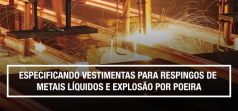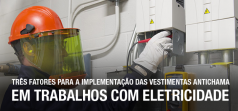Estamos nos aproximando dos meses mais quentes do ano, portanto, é muito importante abordarmos a questão do estresse térmico e como podemos mitigar seus riscos.

Where we share our perspective on current trends, best practices, and the future of FR safety.

Estamos nos aproximando dos meses mais quentes do ano, portanto, é muito importante abordarmos a questão do estresse térmico e como podemos mitigar seus riscos.

Flame resistant (FR), arc-rated (AR) personal protective equipment (PPE) is an important part of establishing a well-rounded safety program. Before donning their FR/AR PPE, however, employees need to be educated about their PPE garments so they can properly guard themselves against workplace hazards such as arc flashes or flash fires. Understanding how to wear PPE, what their PPE will help protect against, and how to care for their PPE is essential for end users’ safety. We rounded up five important reasons to train employees about their PPE.

Part of designing reputable protective fabrics is ensuring they provide certified, consistent results both in the lab and in the field—otherwise, end users may be at risk. Flame resistant (FR), arc-rated (AR) fabrics incorporated into personal protective equipment (PPE) act as a final layer of defense against hazards like arc flashes and flash fires, so these fabrics must perform. But how does a company like Westex by Milliken assess performance? We sat down with James Cliver, senior development engineer for Westex by Milliken, to learn more about how FR/AR fabrics are tested and why standard testing protocols are a crucial indicator of performance.

When we look to develop new flame resistant (FR) technologies, we often draw inspiration from unmet needs in the industry. Many times, our conversations in the field help us better identify areas where we can fill a gap to better protect workers in the electrical and oil and gas industries against arc flashes and flash fires. We sat down with Paul Castelli, international sales director for Westex by Milliken, to learn more about how Westex develops new technologies.

Vários setores da indústria apresentam riscos ocupacionais causados por respingos de metais originários de solda, fundição de metais ferrosos e alumínio. É importante que os trabalhadores conheçam e estejam protegidos durante sua jornada de trabalho. A área de segurança do trabalho deve fazer uma análise detalhada destes riscos térmicos e implementar um programa de vestimentas antichama compatível com a análise efetuada.
Vamos analisar alguns destes riscos e como proteger o trabalhador: Read More

Until recently, flame resistant (FR), arc-rated (AR) garments were one size fits all—meaning both men and women wore the same styles. Women in the oil and gas and electrical industries thus donned ill-fitting FR/AR garments day in and day out, because these garments were largely constructed with men in mind. Typically, women have to find FR/AR garments that mostly fit then adjust them throughout the day as they shift out of place.

For worksites where short-term thermal hazards are present, flame resistant (FR), arc-rated (AR) personal protective equipment (PPE) is a critical component in providing protection in the event of an unexpected incident, like arc flash, flash fire, or dust combustion. While key, however, it is important to note that when designing your safety program, daily wear FR/AR PPE is one of many parts of a comprehensive thermal hazard mitigation program.

Os trabalhadores da área elétrica estão expostos a perigos inesperados incluindo os arcos elétricos, portanto, as precauções de segurança devem ser revisadas frequentemente visando reduzir o risco de acidentes. As análises de risco são necessárias para reduzir a probabilidade de ocorrência de um arco elétrico e nunca se pode descuidar quando se trata de proteger estes profissionais. Neste sentido, o EPI é empregado como último controle do gerenciamento do risco com o objetivo de mitigar a gravidade da lesão caso ocorra um incidente de arco elétrico. Read More

Drawing from customer feedback and suggestions, the Westex® DH line of performance flame resistant (FR), arc rated (AR) fabrics was created to meet the most requested and pressing end-user needs for thermal hazard FR/AR personal protective equipment (PPE). Durable and robust, the line offers superior arc flash and flash fire protection in a variety of garment weights and styles for FR/AR daily wear. With fabrics ranging from a basket weave fabric ideally suited for cargo pants to a durable construction for button-down shirts, the line is expanding to include an innovative fabric for FR/AR base layers, which will debut at the National Safety Council (NSC) Congress & Expo in San Diego Sept. 9 – 11.

Existem muitos fatores que influenciam na criação de um tecido antichama de alta qualidade. Embora existam muitas propriedades relacionadas à resistência à chamas (FR) que são frequentemente mencionadas como durabilidade e certificações, há algumas características que tendem a receber menos atenção.
Reunimos cinco fatos interessantes sobre tecidos antichama (FR) para ampliar seu conhecimento sobre esse importante equipamento de proteção individual (EPI). Read More